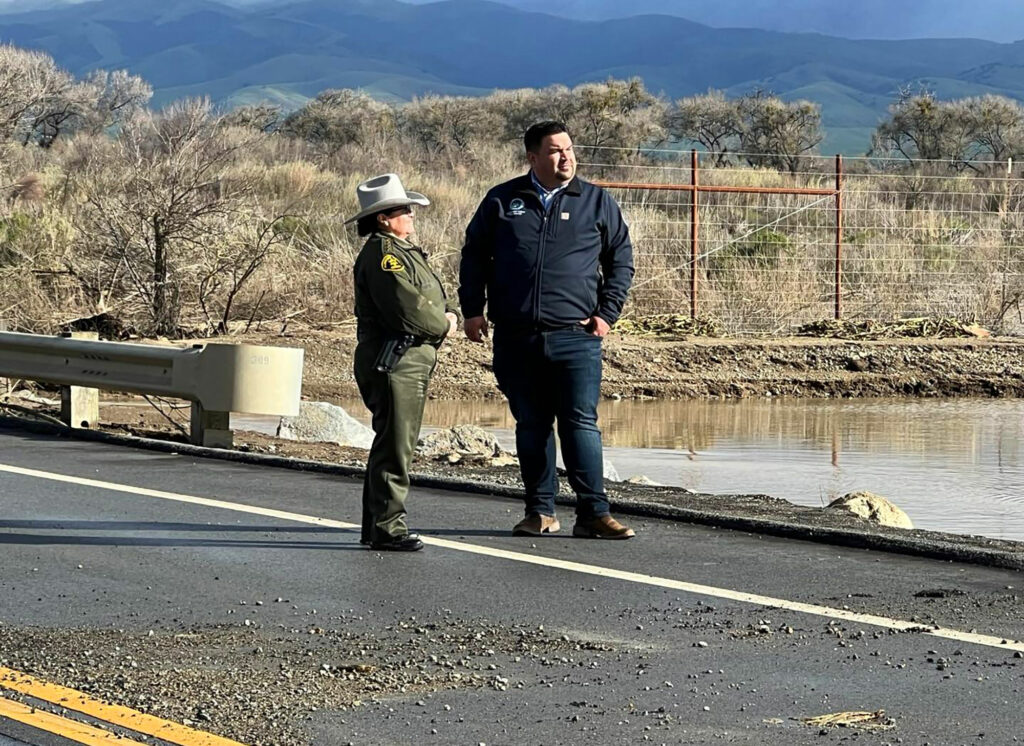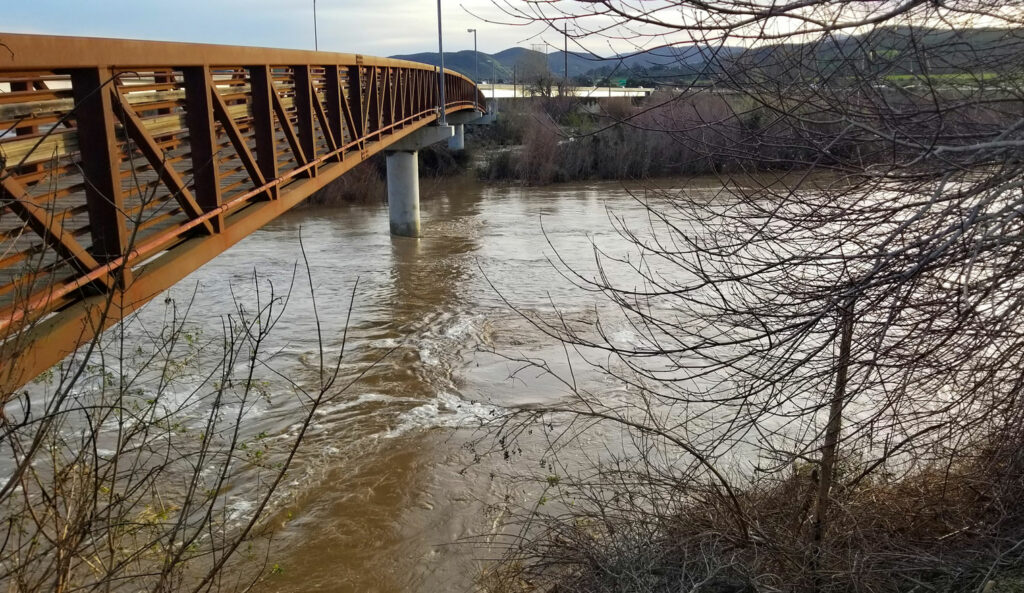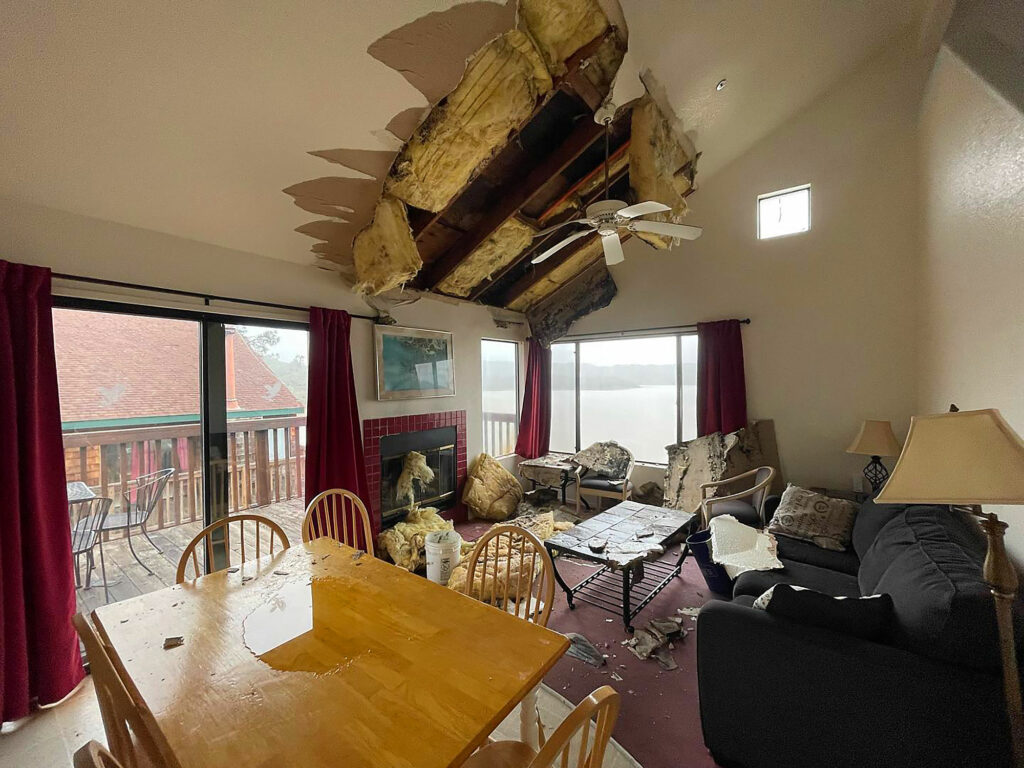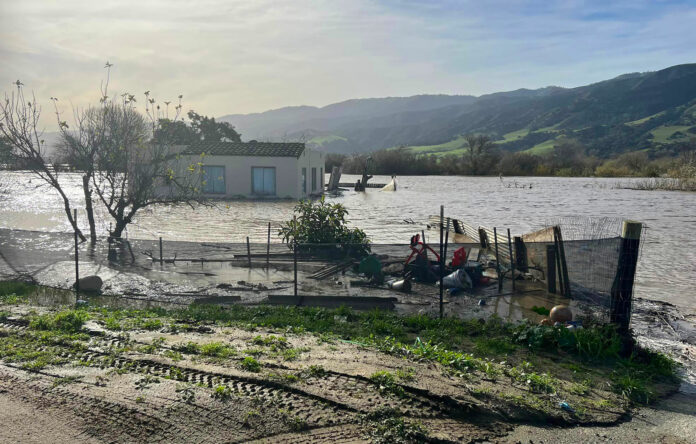MONTEREY COUNTY — Monterey County has released initial damage estimates following the onslaught of recent winter storms that caused major flooding, mudslides and other hazardous conditions throughout the region.
Currently, the county’s Department of Emergency Management is estimating at least $30 million in damages to public infrastructure.
The estimate includes debris removal, emergency protective measures, roads and bridges, water control facilities, public buildings and equipment, public utilities, parks and recreation.
In addition, initial estimates show the local agriculture industry suffering losses between $40 million and $50 million.
The estimates, which are expected to increase as more evaluations get underway, are part of the county’s reporting to the Governor’s Office of Emergency Services.
“Damage estimates are expected to rise as assessments continue,” said Maia Carroll, the county’s communications coordinator, on Sunday.


Storm relief
Though the storms have ceased for now, widespread destruction from heavy rains and flooding have caused hardship for many Monterey County residents and their families.
Tens of thousands of people have been under evacuation orders or warnings due to these dangerous conditions.
As of Tuesday, the county’s population impacted by current emergency notifications was estimated at 15,028, with 109 residents using temporary shelters set up throughout the region.
Call centers, agencies and organizations across the county are receiving offers to help community members during this challenging time, county officials said.
One of the largest nonprofit organizations in the area, the Community Foundation for Monterey County (CFMC), has created the Monterey County Storm Relief Fund to raise funds to provide relief for affected individuals and families.
“Some people have been out of work for weeks now and are in need of food, housing and immediate assistance,” said Krista Hanni, equity officer for the Emergency Operations Center and program manager for Monterey County Health Department. “We anticipate local nonprofits to play a critical role in recovery, and this fund will help support their efforts.”
Donations will provide emergency assistance and relief through local nonprofits for needs, including food, emergency shelter, financial assistance to those evacuated, support for first responders, as well as recovery efforts.
CFMC has so far granted $100,000 to initiate the Storm Relief Fund, and the Monterey Peninsula Foundation, host of the AT&T Pebble Beach Pro-Am, partnered with the CFMC by contributing an additional $100,000 to the fund.
The foundation is accepting donations at cfmco.org/stormrelief, all of which will be used for grant-making to support the affected residents.
“We are grateful for the Community Foundation for Monterey County starting this important fund,” said Monterey County Administrative Officer Sonia M. De La Rosa. “This has been a time for us all to come together, and we’ll continue to support each other during recovery.”
Nonprofit organizations helping with recovery and relief efforts from the 2023 winter storms may be eligible for grants. Learn more about the criteria and how to apply at cfmco.org/stormreliefgrants.
“Even though we can’t yet know the extent of damage and loss from these storms, we’re confident in the generosity of the people of Monterey County and will ensure their gifts help those in need,” said Dan Baldwin, CFMC president/CEO.

Reservoir levels
Recent rains have helped with much-needed reservoir water storage, with room for more, according to the Monterey County Water Resources Agency.
The Agency reported that Nacimiento Reservoir reached a healthy 69% capacity — about 262,000 acre-feet of water — as of Jan. 10. Nearly a week later, the reservoir increased to 87% capacity on Monday.
Lake Nacimiento had been at 42% capacity on Jan. 7.
“Around the clock visual observations and gauges in other locations continue to function accurately and verify that the Nacimiento Reservoir levels are within safe limits,” the Agency said.
Lake San Antonio also increased capacity, from 15% on Jan. 7 to 32% on Monday.
Rainfall totals to date for the lakes, located in southern Monterey County, were 13.59 inches at San Antonio and 11.73 inches at Nacimiento as of Monday. Both amounts surpass last season’s total rain inches of 8.19 at San Antonio and 9.11 at Nacimiento.
The Agency confirmed the Nacimiento Reservoir continues to release a minimum year-round flow in accordance with regulatory requirements of 60 cubic feet per second (CFS). CFS is the flow rate or discharge equal to one cubic foot per second, or approximately 7.48 gallons per second.
Over the weekend, the county began minimal flood control releases at the reservoir. The small releases increased from 60 to 350 CFS, and will slowly rise to under 4,000 CFS for about a week — compared to the flood stage flow of the river that was more than 40,000 CFS during the recent storms.
“It is not safe to keep the flood pool (the term used to describe the upper capacity of the reservoir) full,” De La Rosa explained. “With the recent weather, now is the best time to begin this normal operational procedure.”
County experts are timing the releases to compliment the lower river levels at the south end of the Salinas Valley. Because it takes three to five days for water to travel from the Nacimiento Reservoir to Spreckels in the north, the current river flood levels at that location will have passed.
“It is healthy for the system to release small amounts of water now, versus waiting and having to release larger amounts of water later,” said Monterey County District 3 Supervisor Chris Lopez.

Water contamination
In the small community of San Ardo, south of King City, residents are being advised to not drink water from the town’s water system due to contamination from the floods.
“The residents of San Ardo are still advised to not drink the water, use the water for food prep, or for brushing teeth,” said the Monterey County Health Department’s Environmental Health Bureau in a news release Jan. 14. “The water can be used for showering or bathing, but you should avoid getting any in your mouth or open wounds. If you have concerns, you may contact your doctor.”
According to the Environmental Health Bureau, the water district is working on removing any contamination so the water will be safe to drink again. Multiple days of testing will be done to confirm the contamination has been removed, health officials said.
Residents can contact the Environmental Health Bureau at 831-755-4505 with any questions or concerns.

Park update
Pinnacles National Park, located about 5 miles east of Soledad, has re-opened after closing due to flooding and hazardous conditions last week. While some damage remains, the park was able to resume operations on both entrances as of Friday.
A few trails and roads, however, will remain closed for servicing or more time to allow hazards to abate; the Balconies and Bear Gulch caves, the Chaparral parking lot and the Chalone Peak trail beginning at the reservoir are closed pending further repairs.
“The rest of the park is once again open to visitation and hiking,” said the National Park Service (NPS) on Friday. “Visitors are still strongly encouraged to exercise caution as hazards may still remain from the storm, and new hazards can always arise from continued rain and wind conditions.”
Several trails, such as Old Pinnacles, are open but have multiple creek crossings that require hikers to be calf-deep in the flowing river.
“Tree and rock falls on roads and trails, and rivers running over the roads and trails at stream crossings, are the most common environmental hazards a visitor is likely to encounter when visiting after a storm,” NPS said. “Use extreme caution when recreating in wild spaces, such as National Parks. Conditions can change rapidly, and don’t always reflect the expectations of current weather. It is critical that visitors plan ahead, as certain routes may not be passable due to closures and hazards.”

Forest closure
Los Padres National Forest officials issued a 60-day closure order on Jan. 13 for four ranger districts in response to last week’s winter storm. The closure order takes effect immediately for the Monterey, Santa Lucia, Santa Barbara and Ojai ranger districts.
Forest employees will be assessing the extent of the damage over the coming weeks and months and will scale back the closure based on improving conditions.
Over the past month, Los Padres received more than 100% of its annual rainfall along with extremely damaging wind events. The “atmospheric river” delivered record rainfall amounts Jan. 8-10 ranging from 17 inches at San Marcos Pass on the Santa Barbara RD to 18 inches in the Ojai RD backcountry.
According to Los Padres Forest Supervisor Chris Stubbs, these weather events have caused flooding, debris flows, slope failures, bridge, road and trail failures, and serious impacts to administrative and recreation facilities. Public access to Los Padres recreation sites is limited or not currently possible due to compromised roadways.
“We’re taking this precautionary step to ensure visitor safety as we determine the extent of the damage and develop a strategy to prioritize and address the extensive impacts to infrastructure and natural resources,” Stubbs said. “I’m asking the public to heed the closure order while these recovery efforts are underway. My intention is to re-open closed areas as soon as it’s safe to do so.”
The full extent of damage to the Forest will be known once a full assessment is completed, which will likely take many weeks, Stubbs said. Forest personnel are continuing to work with city, county and state partners on post-storm damage assessments and repairs when conditions are safe for work and travel.
U.S. Forest Service law enforcement officers are enforcing the closure order, which carries a penalty of $5,000 and/or six months in jail. For more information, visit Los Padres National Forest’s website fs.usda.gov/lpnf.














